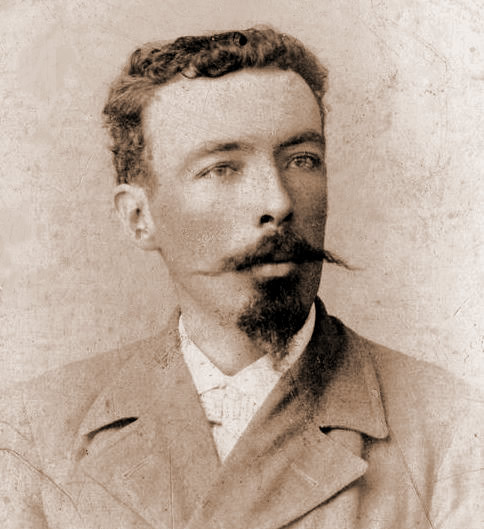Luis Alfredo Martínez Holguín (Ambato, June 23, 1869 – Ambato, November 26, 1909) was an Ecuadorian writer, painter, politician, and agriculturist. His novel A la Costa (1904) is considered a masterpiece of Ecuadorian literature and one of the earliest works of realism in the country. In addition to his literary achievements, Martínez was a skilled painter, with several of his best works housed internationally, including in the United States Library of Congress and the Vatican Museum. Politically, he opposed the government of Eloy Alfaro and was involved in the resistance against liberal guerillas in the 1890s.
Early Life and Education
Luis Alfredo Martínez Holguín was born on June 23, 1869, in Ambato, Ecuador, to Nicolás Martínez Vásconez and Adelaida Holguín Naranjo. He was one of twelve siblings, several of whom made significant contributions to Ecuadorian literature and the arts, including Anacarsis Martínez and Augusto N. Martínez. His early education took place at the Colegio San Gabriel in Quito, but he left school without completing his studies, choosing instead to focus on painting and writing while helping manage his family’s agricultural properties.
Personal Life
In 1896, Martínez married his second cousin, Rosario Mera Iturralde, daughter of the renowned poet and novelist Juan León Mera, who wrote Cumandá, Ecuador’s first novel, and the national anthem. Despite the political tensions between the conservative Mera family and Martínez’s liberal leanings, their marriage was a happy one. They had two children: Blanca Martínez Mera, who became Ecuador’s first female novelist, and Luis Edmundo Martínez Mera, a noted painter. Tragically, both Rosario and one of their children died in the early 1900s, deeply affecting Martínez in his later years.
Literary Career
Martínez is best known for his 1904 novel A la Costa, a pioneering work of realism in Ecuadorian literature. The novel explores the social, political, and cultural changes brought by Ecuador’s Liberal Revolution (1895) and is regarded as one of the greatest Ecuadorian novels of its time. It delves into the conflicts between the conservative highlands and the progressive, liberal coastal regions, while also addressing themes of religion, migration, and the shifting social order. Martínez’s realist style was influenced by his background as a painter, allowing him to portray Ecuador’s landscapes in rich, vivid detail.
Beyond A la Costa, Martínez wrote several essays and short stories, including Cartas de viaje (1897) and Disparates y caricaturas (1903). His works reflect his engagement with Ecuador’s political and social issues, particularly the need for modernization, agricultural reform, and educational improvement.
Political Involvement and Public Service
A staunch supporter of the Liberal Revolution led by Eloy Alfaro, Martínez initially engaged in the guerilla warfare that characterized the revolution, but later became an opponent of Alfaro’s government. He held various political roles, including serving as the deputy for Tungurahua and later as Ecuador’s Minister of Public Instruction (1903-1905). In this position, he championed educational reforms and founded the Escuela de Bellas Artes in Quito and the Escuela Normal de Agricultura in Ambato. He was also a strong advocate for infrastructure projects, such as his ambitious but unrealized plan to construct a railroad to Ecuador’s Amazon region.
Artistic Contributions
In addition to his literary achievements, Martínez was an accomplished painter, primarily known for his realistic depictions of Ecuador’s landscapes. His works, often compared to the romanticism of earlier painters, are characterized by their scientific precision and attention to detail. Many of his paintings are housed outside Ecuador, including two in the United States Library of Congress, two in the Vatican Museum’s Modern Art section, and one in Rio de Janeiro, Brazil. Martínez’s experience as a mountaineer and naturalist greatly informed his art, as he sought to capture the sublime beauty of the Ecuadorian wilderness.
Later Years and Death
In his later years, after suffering personal tragedies—the death of his wife in 1905 and one of his children in 1906—Martínez withdrew from public life. He suffered from tuberculosis, which eventually led him to retire to his family estate in Ambato. He died on November 26, 1909, at the age of 40.
Legacy
Luis Alfredo Martínez remains a seminal figure in Ecuadorian literature and art. His novel A la Costa is considered a foundational text of Ecuador’s realist literary tradition, and his paintings continue to be celebrated for their intricate portrayal of the country’s landscapes. His contributions to education and culture through public service, as well as his artistic and literary output, have left an enduring legacy in Ecuadorian national identity. His memory is honored through institutions such as the Casa Museo Martínez-Holguín in Ambato and the Salón de Pintura Luis A. Martínez.
Works
- A la costa (1904)
- Disparates y caricaturas (1903)
- La Agricultura ecuatoriana (1903)
- Camino al Oriente (1903)
- Catecismo de la agricultura (1905)
References
- Wikipedia, “Luis Alfredo Martínez.” Retrieved on October 5, 2024. Click to view.
- Enciclopedia del Ecuador, “Luis A. Martínez.” Retrieved on October 5, 2024. Click to view.
- Cervantes Virtual, “Luis A. Martínez.” Retrieved on October 5, 2024. Click to view.
- EcuRed, “Luis A. Martínez.” Retrieved on October 5, 2024. Click to view.
- MCN Biografías, “Luis A. Martínez.” Retrieved on October 5, 2024. Click to view.
- Wikipedia, “A la Costa.” Retrieved on October 5, 2024. Click to view.

